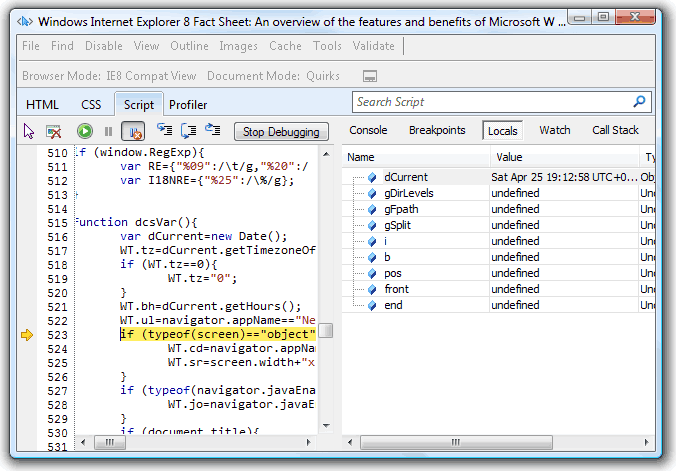 This is the second part of my IE8 review. Part 1 covered installation, the interface and new features but here we look at what the browser offers to developers…
This is the second part of my IE8 review. Part 1 covered installation, the interface and new features but here we look at what the browser offers to developers…
Page Rendering
Here is the good news: IE8’s HTML and CSS rendering is excellent. In my limited tests, it behaves almost identically to Firefox and the other mainstream browsers. Perhaps it should have been right years ago, but let’s be thankful.
IE8 is more standards-compliant than IE7 but, to help people upgrade, it offers three rendering modes:
- IE8 mode: the browser runs as IE8 — yay!
- IE7 mode: the browser runs as if it were IE7 and returns that browser’s user-agent.
- IE8 compatibility mode: the browser runs as IE8, but behaves like IE7.
I’m not certain why Microsoft bothered with the last option, but IE7 rendering appears accurate in all the pages I tested. However, the company missed a trick by not providing an IE6 mode: that would have had a far greater effect on upgrades and would have contributed more to killing off the 8 year-old browser.
JavaScript Performance
All browser manufacturers claim their JavaScript engine is the fastest. IE8 does not feel spectacularly quick on JavaScript-heavy sites and I eventually tested it using the SunSpider benchmark suite. The results were not impressive: on my PC, IE8 was more than 60% slower than Firefox 3.0.9 — a browser that is known not to be the quickest.
IE8 still has the awful modal JavaScript error window. The browser does not show it by default, but an error console would be far more useful.
Developer Tools
Finally, IE offers us some great built-in developer tools. Press F12 and you are presented with a window that allows you to examine the HTML, modify the CSS, step through JavaScript code, and profile bottlenecks.

The tool offers a hybrid of features blatantly copied from the Firefox Web Developer Toolbar and Firebug extensions. It’s not as good as either and it looks like a beta product, but it’s a welcome addition and will help IE development immensely.
Conclusion
I have been quite critical of IE8, but it is moving in the right direction and is far better than IE7. I would certainly recommend the upgrade for the page rendering and developer tools alone.
As a browser, IE8 is not terribly exciting. The new features are a little gimmicky and the interface has a slightly inconsistent and unfinished feel. Why can’t IE open the last session on start-up? Why can’t I choose tab colors? Why offer three different rendering modes?
Microsoft try hard to make their applications suitable for users at all levels of experience and IE8 is no exception. Unfortunately, although they have taken the best features from other browsers, they hide them from novices and made them awkward for experts. IE8 often gives the impression that it knows what’s best for you.
For novices or those who want fast, unencumbered browsing, Google Chrome, Apple Safari, or a basic Firefox installation probably offer a better experience. For expert users, Opera or an extension-powered Firefox will be preferable. It is tempting to say that IE8 is suitable for the “average” user, but I’m not convinced it is.
Overall, IE8 is a welcome addition to a healthy and increasingly crowded browser market. I am glad Microsoft have revived the product and Windows users should not hesitate in upgrading. However, it is unlikely to sway many away from their current browser of choice. Few people would argue that IE8 is the best browser available; its user share probably owes more to strict corporate policies and user inaction.
See also:
Will you install IE8? Do you like it? Has it persuaded you to switch from a competing browser?
Craig is a freelance UK web consultant who built his first page for IE2.0 in 1995. Since that time he's been advocating standards, accessibility, and best-practice HTML5 techniques. He's created enterprise specifications, websites and online applications for companies and organisations including the UK Parliament, the European Parliament, the Department of Energy & Climate Change, Microsoft, and more. He's written more than 1,000 articles for SitePoint and you can find him @craigbuckler.


